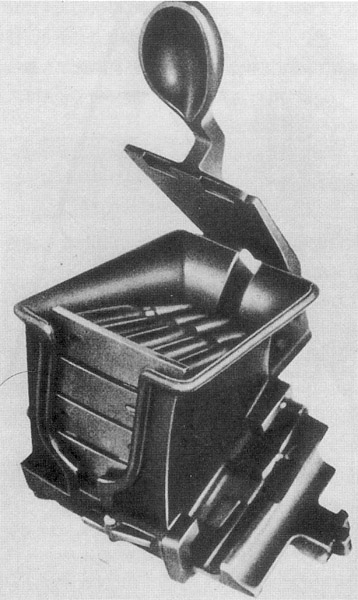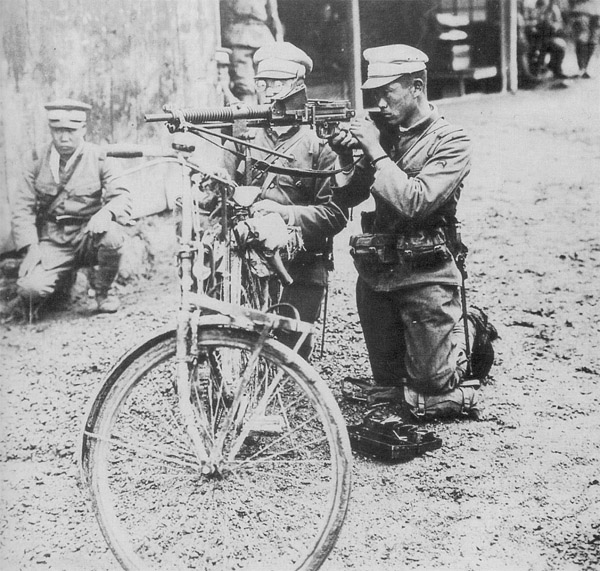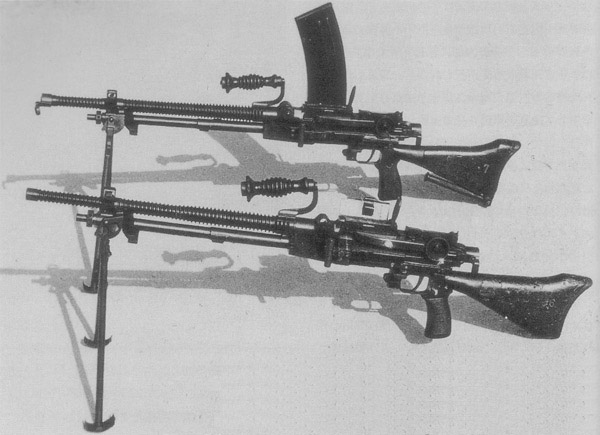http://www.lonesentry.com/articles/ttt/japanese-weapons-artillery.html
“CHARACTERISTICS OF PRINCIPAL JAPANESE WEAPONS”
Crap?
:lol: :lol: …not everyone, they had some nice ones like the knee mortar

The sniper version of the 7,7mm rifle was very accurate, off course cannot be compared with a Garand M1 or a G-43.
:lol: :lol: …not everyone, they had some nice ones like the knee mortar

The sniper version of the 7,7mm rifle was very accurate, off course cannot be compared with a Garand M1 or a G-43.[/quote]
True. That weapon was a terror from what I heard, the Japs knew how to drop a round right on Allied warriors…
And more than a few Marines/soldiers broke their femur when they tried to brace the weapon by placing it on their leg, instead of the ground like it was intended when firing captured mortars back at the Imperial Army…
That Japanese also had a few good light machine guns that could be very effective… But overall, their infantry weapons were lacking (no anti-tank weapon?)
But the Japanese surely made up for their poor overall weapons with an immense fighting spirit of self-sacrifice, or “Third Force.”
Probably the most crapy of all the japanese weapons is this, the suicide AT hollow charge wich was mounted in lunge.
The poor soldier had to press it against the armor to make it detonate, as long the wooden rod may be the blast and metal fragments got the user killing or seriously wounding him. :?
The job of japanese “Panzerjager” really sucks in those days.
The Japs were crazy sun of a guns. They had many weapons that were suacide weapons. You are then just killing your own army. :lol:
Henk
I’ve also hear that Japanese soldiers used to sit in covered holes with an unexploded bomb, and a hammer to detonate it, and wait for a Sherman to drive over it.
That is correct, generally was an 50 kg aviation bomb. The suicide soldier I guees that would need some kind of dental identification after that. :?
Other more practical weapon was this, a throwing shaped charge the Type 3 AT Grenade
Officially, it was able to destroy a 70 mm thick armor.
:lol: :lol: …not everyone, they had some nice ones like the knee mortar
…[/quote]
True. That weapon was a terror from what I heard, the Japs knew how to drop a round right on Allied warriors…
And more than a few Marines/soldiers broke their femur when they tried to brace the weapon by placing it on their leg, instead of the ground like it was intended when firing captured mortars back at the Imperial Army…
…[/quote]
Hopefully the Japanese made a similar error when encountering the US ball grenade…
More info about the japanese infantry weapons can be found in here.
http://www3.plala.or.jp/takihome/infantry.htm
Type 100
Type 38 Rifle
Introduced Year : 1905
Caliber : 6.5 mm
Barrel Length : 797 mm
Length : 1,280 mm
Weight : 3.95 kg
Muzzle Velocity : 765 m/sec
Range : 3,000 m
Magazine : 5 rounds
Production Qty : 3,400,000
Type 97 Sniper Rifle
Introduced Year : 1937
Caliber : 6.5 mm
Barrel Length : 797 mm
Length : 1,280 mm
Weight : 3.95 kg
Muzzle Velocity : 765 m/sec
Range : 3,000 m
Magazine : 5 rounds
Type 97 is the same as Type 38 Rifle, except a telescopic sight.

with the exception of the 7.7mm version of their top magazine LMG, ALL of them had poor primary extraction.
Given that all the original hotchkiss LMG’s and MMG’s had good ‘primary extraction’ (even the Chauchat did!) this must be presumed to have been an ‘extra feature’ provided for the IJA by Colonel Nambu. Who cleraly knew bugger all about conditions in and around the cartridge chamber walls immediately after firing.
If you want an automatic weapon the bolt (and extractor combined) have to have, for a brief period only and over a very short distance only, a very high ‘mechanical advantage’, pull or torque if that helps.
To pull the very hot cartridge case - still expanded and thus stuck to the very hot chamber walls - out from the breach, in time to make the firing rate worth having.
This led to lubricated cartridges.
That this is NOT hard to do is demonstrated by the fact that most other nation’s automatic small arms did NOT have this problem
Other than Italy’s MG’s, which had the same problem, pity the poor Italian MGers in the desert with oiled cartridges!
In addition to the above, what also sometimes cause this problem is unlocking and attempting to extract too early whilst the cartridge case is still obturated. this can also result in the extractor tearing through the rim, as in the early Colt production M-16’s.
Sorry if this is a dumb question but my knowledge of the mechanical workings of fire arms is…shall we say, lacking. To me it is all magic. You put a round in the chamber, squeeze the magic level and abracadabra…your target is perforated.
In the conditions described by Timbo in Oz and Man of Stoat did this cause a porr firing rate or did it cause frequent jamming?
Yes it does, the lubricated shells also increased the amount of stress in the bolt s face, making prone to damaging the entire gun locking sistem.
japanese army infantryman, 1941.

is that true that they didnt really care about machine gun because they thought machine guns are not as accucate weapon as rifles?
I dont thnk so, the japs used MGs as far as any other major player in the WW2.

In fact, I think their light machine guns were pretty good on the whole. The Japanese did lag behind on submachineguns though.
I just can’t agree that their LMG’s were okay or pretty good, but they did do okay with them. All the Hotchkiss base MMG’s the woodpeckers had the same extraction problem.
To top this all off by mid war they had three(4?) different infantry cartridges, a 6.5mm, and a lower loaded item for the original LMG, and two 7.7mm items, ballistically and externally identical, except one was rimless and t’other semi-rimmed. the rimmed round was a copy of the .303 british used by the IJN in the Vickers guns in the Zero, butts in the cockpit, just like in a WWi fighter
The main LMG at the beginning of WWII was the abortion with an open hopper so it COULD take standard 6.5mm rifle clips form the section’s riflemen. Y you could fire a 2-rnd burts and then a 3-rd and then wait until the clip fell out and the next one indexed across.
But it COULDN’t use the riflemen’s rounds, because even if you oiled them the charge in the standard rifle cartridge was too powerful for the action to survive such use. hence the specail lower power cartridge which also move away from the sighting assumptions.
The next most important was the re=development of this weapon (by Colonel Nambu yet again) with a Bren style magazine. This model was capable of using the standard 6.5mm rifle cartridge, but they still had to be oiled!
The only LMG that did have good primary extraction was the 7.7mm version of the above. which fired a 7.7mm semi-rimless round otherwise identical to the fully rimmed and rimless 7.7mm rounds
It was never introduced in large numbers and only half way through the Pacific War.
Hi.
No, the japanese mg-gunners were taught to fire well aimed short bursts instead of continuous fire. This increased accuracy, saved ammo and decreased the temparature of the mg during action.
The problem the army had with automatic rifles and smg was that they thought, the average infantry soldier would use too much ammo. They didn´t really thought that the average japanese soldier would be able to control himself while firing like mg-gunners did…
The problem of oiling the cartridges was also caused in the ammo used as Timbo in Oz mentioned.

The type 38 6,5 mm rimmed infantry round had been developed for a single fire rifle and the the type Taisho 11 lmg were built for this ammo but had major problems.

This is why special 7,7 mm rounds were developed for the type 92 naval mg, the type 92 hmg (the infamous Woodpecker) and also for the type 99 lmg (based on the type 99 rifle ammunition).
In 1941 the japanese Army and Navy used the following small arms ammunition types officially (maybe not complete):
- 7,1 mm nambu for the small type Taisho 10 pistol (Baby Nambu)
- 7,62 mm for the Mauser C96 (mainly Kwantung Army)
- 8 mm nambu for the type Taisho 10 pistol, the type Taisho 14 pistol and the type 94 pistol
- 9 mm for the type Meiji 26 double action revolver
- 6,5 mm tor the type Meiji 38 rifle, the type Meiji 38 carabine, the type Meiji 44 carabine, the type 97 sniper rifle and the type 96 lmg
- 6,5 mm for the type Taisho 11 lmg
- type 89 7,7 mm for the Vickers type naval hmg and the type 89 hmg
- type 92 7,7 mm for the type 92 and 98 hmg
- type 99 7,7 mm for the type 99 rifle and the type 99 sniper rifle
- type 99 7,7 mm for the type 99 lmg and the type 1 hmg (both in pre-series test production)
- 7,92 mm for the Mauser 98k carabines captured in China and the licence-built aircraft mg 15 and 17
During the war a special 7,7 mm round based on the type 99 rifle round was developed for the naval type 5 automatic rifle and a 7,65 mm round for the type 1 Hamada pistol. All other new developments (type 100, type 1 and type 2 TERA rifles; type 100 mp; type 3 hmg) used existing ammunition.
The type 96 lmg was in fact not a remodeled type Taisho 11 lmg but a remodeled czech type ZB 26 7,62 mm lmg (the infamous Bren was also remodeled from the ZB 26). Some of these modern lmg where captured in China.

The one in the back is a special version for parachute troops…
Yours
tom! 
